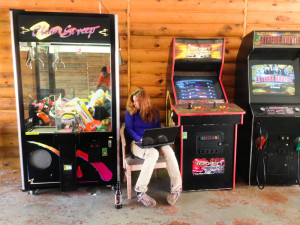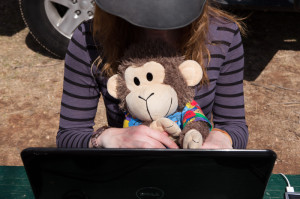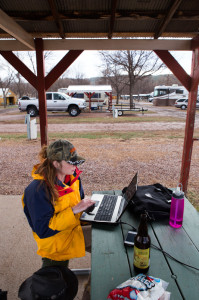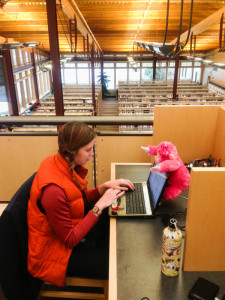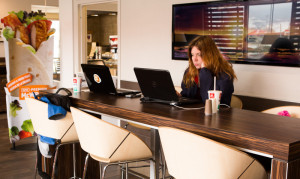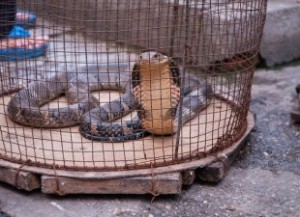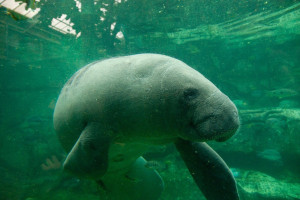Our visit to Mt. Rushmore started off like pretty much like anyone else’s. We flashed our Annual National Park Pass at the ranger, parked the car, and trekked through the hallway of flags towards the giant heads carved into rock.
 Following the path past the information office and the cafe, the Grand View Terrace was the first viewing spot.
Following the path past the information office and the cafe, the Grand View Terrace was the first viewing spot.
Since we were visiting the monument in early April, the crowds were amazingly slim. It really peaceful visiting the popular tourist attraction without screaming kids and over-55 crowd tour buses blocking the view.
 Plenty of tourists have visited Mt. Rushmore, so what makes my visit blog-worthy? Creatures. That’s what…creatures.
Plenty of tourists have visited Mt. Rushmore, so what makes my visit blog-worthy? Creatures. That’s what…creatures.
My boyfriend and I never travel just the two of us. Ask any of our weirded-out friends, and they’ll confirm. I’ve been an obsessive gnome collector for the past ten years. In response to my gnome obsession, he has developed an equally unhealthy obsession with monkeys.
Three gnomes and four monkeys accompanied us to South Dakota.
 With that being said, gnomes made of ceramic and monkeys made of stuffing follow us wherever we go. It doesn’t matter if we’re coming to your birthday party at a bar or a month-long work-cation, creatures will be in tow. And you’d better find it amusing.
With that being said, gnomes made of ceramic and monkeys made of stuffing follow us wherever we go. It doesn’t matter if we’re coming to your birthday party at a bar or a month-long work-cation, creatures will be in tow. And you’d better find it amusing.
Why, you ask? Because it’s a hell of a lot more fun, that’s why.
Creatures provide us with someone else to talk to after being in the car with each other for fourteen hours. After missing showers while camping for a week, the last thing I want to have is my picture taken. However, gnomes and monkeys are always photogenic. While we aren’t responsible enough yet for dogs or kids, creatures provide the fun parts while skipping over the bad.
There is one, and only one, trail that goes around Mt. Rushmore, called the Presidents’ Trail. Clever.
It’s an incredibly easy walking trail that’s well less than a mile and that pretty much anyone can do. There’s park benches along the trail and different views of the heads around every turn.
I must say, I was surprised that there weren’t more informational plaques along the trail. There was one for each president, which offered “fun facts” like education level and major accomplishments..but only one each.
While sparse, the plaques were easy to read and not dreadfully stiff. The ADD crowd thanks you, Park District. There were a couple plaques about the construction of the monument towards the end of the trail.
On our way out, we satisfied our consumer tendencies and popped in the gift shop. Fortunately, it was the only sales location on the premises, so the monument was only moderately commercialized. The gift shop was huge and carried all the usual fare.
My boyfriend convinced me to start collecting patches from national parks, and to eventually sew a travel satchel to stitch them onto. I’m quite the novice when it comes to sewing, but I’d love to put my machine to good use for projects like this. I also picked up a souvenir charm for my ongoing travel collection necklace, a cheesy souvenir bandanna for upcoming bad hair days, and a shot glass for his growing (but dreadfully underused) collection.
At the end of the day, he got some amazing shots of the four heads, which are way better than any stock photography I’ve ever seen. We even went back to the monument after hours to snap some night shots.
Awesome, but under-publicized fact: You can get into Mt. Rushmore from about 5pm and 9pm for free. The ranger station closes at 5, but the gate is left open to drive through. The park lights up the monument at sunset, which was around 7:30pm when we were there.They shut all the lights off about an hour later and expect you to head ’em up, move ’em out by 9ish.
The Mt. Rushmore at night photography collection will be coming soon, however, my all-time favorite pictures are the ones with our creatures. Millions of people has pictures of Washington, Lincoln, Roosevelt, and Jefferson’s heads carved into the side of a mountain. However, no one in the world has pictures of Ginger, Sheldon, and Peso soaking up the view in various poses.







